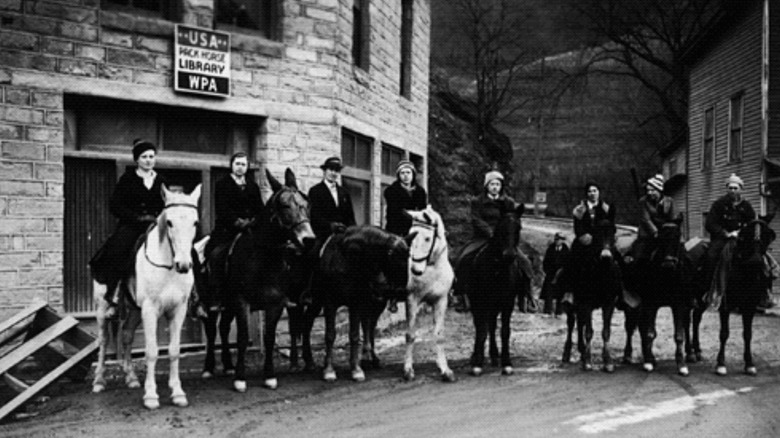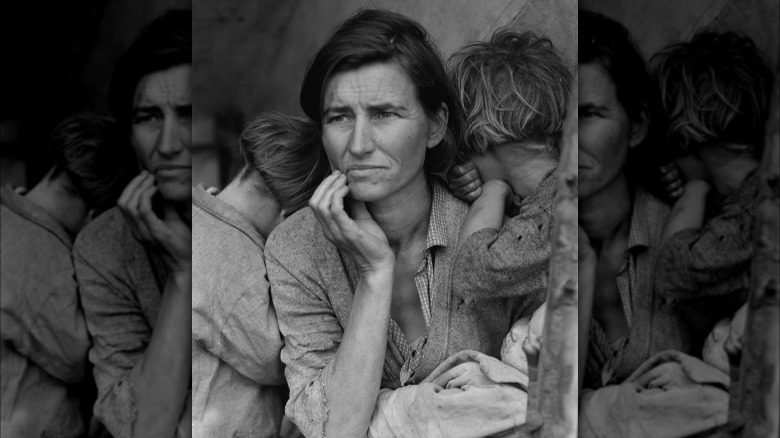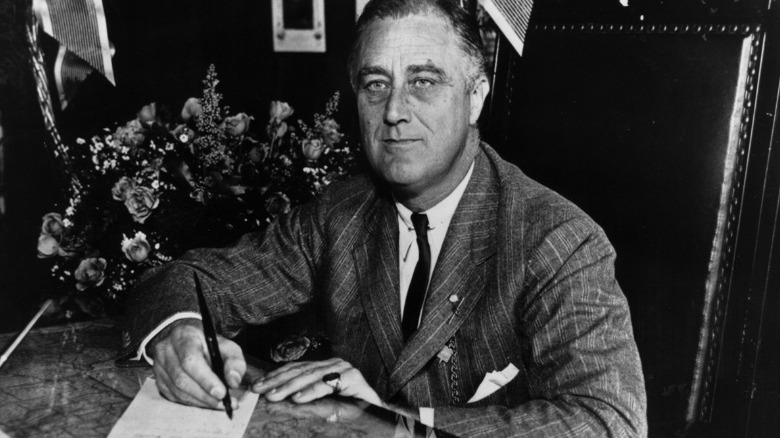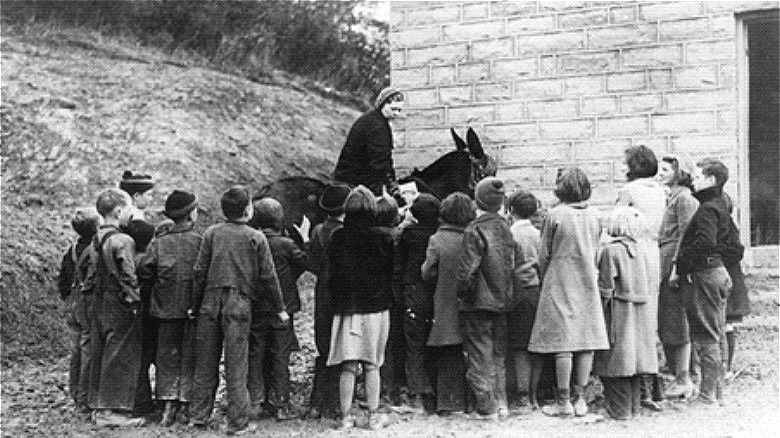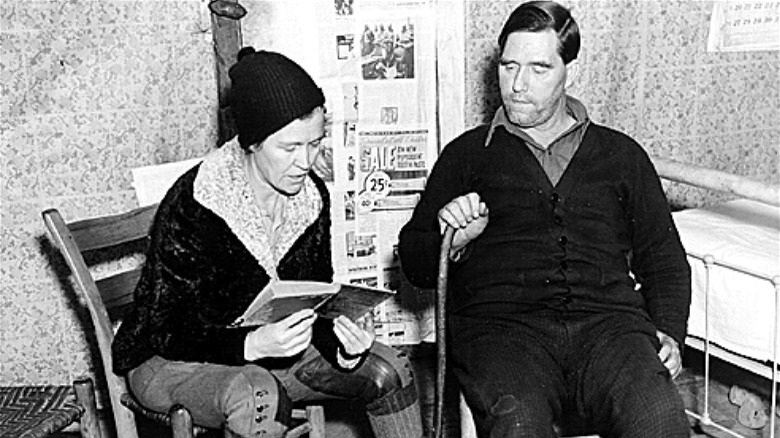Librarians Delivering Books On Horseback Was A Thing Once. Here's Why.
The concept of massive book collections dates back to ancient times and history is filled with stories of some incredible libraries that influenced the human experience. Some of these ancient libraries include the Great Library of Alexandria, the Imperial Library of Constantinople, and the Library of Ashurbanipal. The modern world still maintains some impressive houses of knowledge like the British Library and the Library of Congress.
Though libraries serve as bastions of knowledge, some individuals may have limited access to these physical locations. You have to have the ability to get to and from the library to use the books and other materials inside. If you live in a rural area or your country experiences war or economic difficulties, it may be challenging or even impossible to get to a library. This was exactly the case during the Great Depression, especially outside of the big cities. In an effort to help pull the country out of the slump it was in, a program was implemented to bring the books to the people. It relied on librarians delivering said books on horseback.
[Featured image by Works Projects Administration via Wikimedia Commons | Cropped and scaled | Public Domain]
The Great Depression changed America
In October 1929, the stock market crashed and subsequently resulted in one of the worst economic disasters in history, known as the Great Depression. People lost everything from their jobs to their retirement to their homes. In less than two years, six million people in the United States found themselves unemployed with minuscule chances of getting work. Homelessness became a huge problem in the cities, but those outside of them were not exempt from the fallout either.
The farmers responsible for feeding people with their crops couldn't harvest their products because they could not afford to. This would go on to lead to even more food shortages. In addition to not being able to collect the crops they grew, over the next few years, some farmers in certain parts of the country wouldn't be growing anything at all. During the 1930s, the "Dust Bowl" ravaged the Midwest making food production impossible. With no money, no food, no homes, and natural disasters wreaking havoc on the country, the ensuing decade was one of the most challenging in American history.
The New Deal
Despite the bleak outlook on the nation's state of affairs during the 1930s, the president refused to give up. In 1932, Franklin D. Roosevelt was elected President of the United States. He took on the mantle of the most powerful man in the country at a time when his nation was in great distress. However, FDR had a plan to help turn the country around. His idea became known as the New Deal.
The New Deal was a series of government programs implemented by the Roosevelt administration to provide economic relief to the citizens of the United States. These programs were also used with the hope of revamping various industries across the country including farming, finance, and housing. During the first three months of FDR's presidency, the first goal was to provide relief for the unemployed, and multiple agencies were formed for this purpose. These agencies such as the Worker's Project Administration then started different projects to provide work for American citizens, including what would become known as the Pack Horse Library Initiative.
The purpose of the Pack Horse Library Initiative
According to Smithsonian Magazine, the Pack Horse Library initiative sent librarians on horseback to travel to the most rural parts of Appalachia. This project was unique as it required librarians to leave their institutions and brave the elements of the remote parts of eastern Kentucky. This part of the country lacked many features like electricity, highways, and basics such as food, education, and books.
During the 1930s, books were particularly scarce and an estimated 31 percent of the population did not possess the ability to read. There was an alarmingly low number of books even in circulation in the state compared to others in America. Other attempts to get books to the area had taken place between 1913 and the 1920s but they were short-lived and not overly successful. In 1934, the packhorse library started by the WPA began in Leslie County and required the help of the local people to get up and running.
[Featured image by Works Projects Administration via Wikimedia Commons | Cropped and scaled | Public Domain]
Who were these librarians and where did they get their books?
During this time, libraries did not always exist as we know them today. Often they were organized in buildings built for other purposes such as houses of worship. These places then acted as hubs for the carriers to pick up books (per Smithsonian Magazine). The carriers would deliver the books far and wide, braving the intense weather conditions and undeveloped terrain of Kentucky.
The carriers brought reading material with them to share with the people in the state's most remote areas. So, where did the books come from? Most of them were donated. People reached out to PTAs and individuals in more wealthy neighborhoods to have them donate a variety of written resources. Books began to pour in from all over the country. If the reading materials ever became worn out from use, they were then repurposed into "new books" to ensure that they always had enough for those they served.
Despite some pushback, the program was ultimately a success
Though the idea of bringing books to those who had no access to them probably sounds like a great idea, there were those who were initially skeptical. According to INSH, locals originally tried to reject the concept as they were unsure of the types of materials being distributed. The librarians did not let this pushback stop them. Instead, they used quotes from the bible to help allay any wariness. Just that small effort resulted in the initiative being accepted more easily.
Despite the early resistance they encountered these brave librarians on horseback were ultimately successful. By 1936 they were servicing 50,000 families and a large number of schools. The group of horse-riding librarians had reached almost 1,000 in number and delivered books to a total of 29 counties by the time the program was disbanded in 1943. In the 1940s bookmobiles became more common and a safer and more efficient way of getting books to the masses.
[Featured image by WPA of the United States via Wikimedia Commons | Cropped and scaled | Public Domain]
